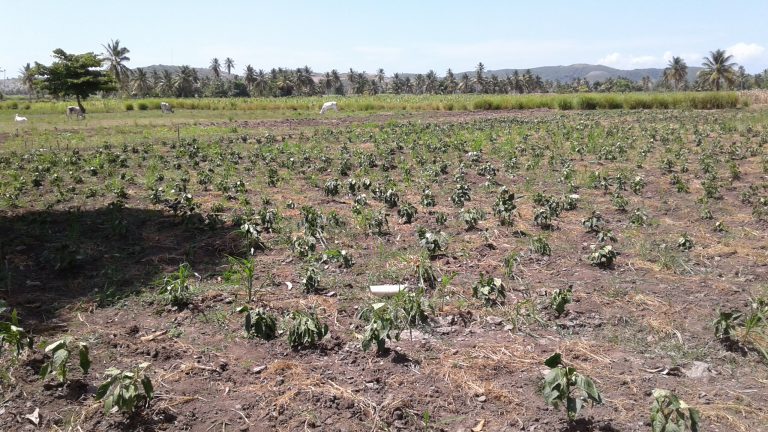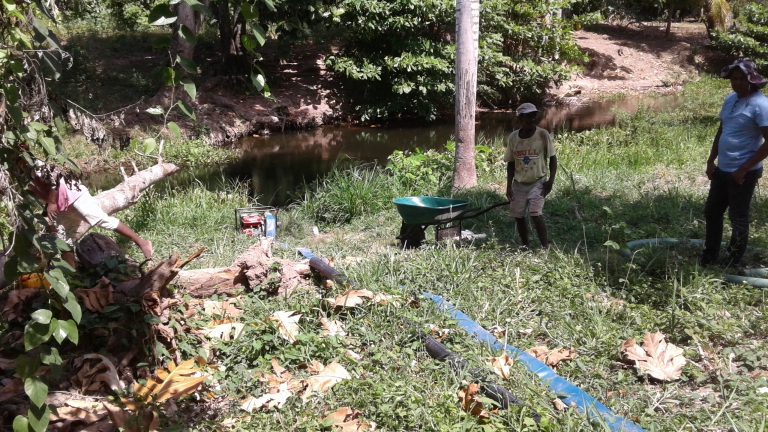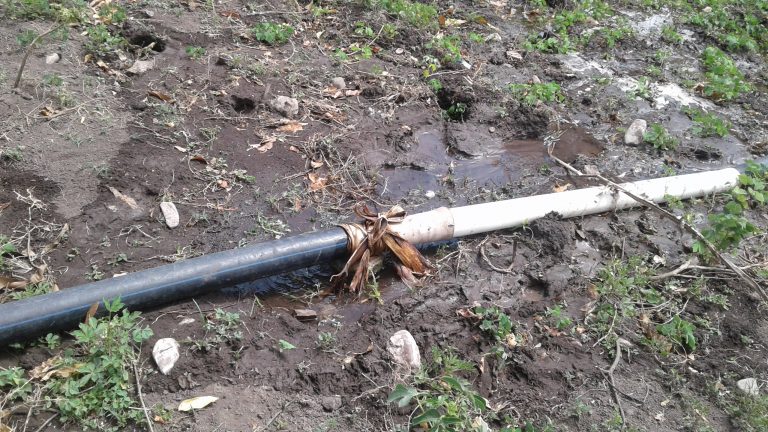As an objective for this endline fieldwork, I want to observe farmers irrigating their fields. By so doing, I seek to not only document the different steps involved in channeling water from a source to a field, but also to get a better understanding of the constraints facing farmers that might limit or even prevent the utilization of the pumps. I am always accompanied for farmer visits by my field coordinator Jery Rambao who has been working on agricultural projects in Haiti for the past five years.
Fritsnel is one of the farmers who were awarded a subsidized irrigation pump in September 2018 through the RESEPAG II project. He lives in the locality of Christine which is a part of Martineau, a subsection of the commune of Cavaillon in Les Cayes. It’s located about five minutes away by car from the national asphalt road.
Fritsnel is an influential farmer. Not only is he well known by most other farmers we talked to in the area, but he also owns a lot of land spread across several plots. One of these plots falls in our intervention area. He assigned another one of his plots to a communal “Farmer School” project. The contract entitles him to facto to 20% of the harvest at the end of the season. Farmer schools are an initiative spearheaded by CA17 International, an international company that works for the RESEPAG II project as a contractor to inform farmers about the government subsidy, register those who are interested in participating in the project and connect eligible farmers to input providers. Another thing CA17 International does is to facilitate farmer schools. This involves organizing up to 28 self-selected farmers into a group that works collectively to produce a set of crops on a plot. Together, the group comes up with creative ways to utilize local resources in solving challenges that they encounter, such as pest control. At the same time, each member of the farmer school is expected to replicate the lessons learnt in his/her own field(s). On this particular farmer school plot, the members planted peppers, water melon, onion and okra, this season. Women hold prominent leadership positions in the organization, such as the presidency and treasury. The plot is fairly small, covering only 5,503 square meters (1.4 acres).
Getting started
We got to Fritsnel’s house around 9:30 am today. He was not there and we were told he had left to feed his cattle a few miles away. We couldn’t reach him on his cellphone, therefore we decided to go find him in the field. We gave Fritsnel a ride back to his house near the farmer school plot. About eleven people had gathered on the plot by the time we arrived, including two extension agents from CA17 International. Among the farmers, were four women and one man told us he was 96 years old. Around 11:00 am when the group decided to irrigate their communal plot, we learn that there was no gas to start the pump. Jery offers to drive back to the asphalt road. He soon returns with two gallons of gasoline that he purchased at GHT 500 (USD 5.4). The fuel is more than enough to fill the pump. With a full tank, the pump usually runs 3-4 hours nonstop, Fritsnel explains confidently.
The dry spell is “killing” the crops
The plot is so dry that that top soil is cracked and the crops look stunted and unhealthy. Farmers tell us that rains are very sporadic this season. “It only rained a few days in March” says one of them, and “there is a significant need to irrigate the field.” The group borrows a pump from another RESEPAG II pump recipient with the nickname of “Mr Sony.” One of the members of the farmer school is a good friend of “Mr Sony” so he is able to use the pump as needed, without paying rental fees.






The water source
Aside from the demand for agricultural activities, the local community depends on the same river for bathing and other needs. The water level is notably lower, compared to my last visit in this neighborhood back in April 2018 while we carried out baseline data collection for the project.
Connecting pipes to the pump
Setting up the irrigation equipment takes quite a team. Farmers carry a 3-inch gasoline pump to the river in a wheelbarrow along with 15 black Polyethylene gated pipes. Each pipe is about 8 centimeters (3 inches) in diameter and 15 meters (16.4 yards) long. The pipes are heavy and sturdy. They need to be connected tightly to one another all the way from the water source to the field. For this, the farmers have a bunch of small, white, lighter pieces of pipes. A longer version of these white pipes is also used on the plot itself, among furrows. Connecting the pipes is no easy task. I was impressed by the farmers’ resourcefulness when they set fire to the extremity of one pipe in order to make it fit into another. The process requires a fair amount of coordination between at least two people, pushing and adjusting pipes of different diameters. Nearly two hours into the operation under the scorching sun, the pump is finally turned on and water begins to flow into the pipes.



Inefficiencies in the irrigation process
The irrigation system is inefficient on several accounts. For instance, it takes a significant amount of water to irrigate a small plot of land. More than half the amount of water that is pumped from the river leaks out due to improperly connected pipes. Also, the process is quite labor intensive, partly due to the lack of a permanent infrastructure. Farmers need to set up the entire irrigation system (pump and pipes) each time they want to irrigate the plot. For lack of proper equipment, farmers have to manually switch pipes in order to reorient water in different direction across the furrows. This process requires farmers to be physically present in the field throughout the operation.
Additionally, irrigation is done by simply flooding different sections of the field and relying on gravity to channel the water into the furrows. This takes a lot of water flowing at a high pressure from the pump into the plot. To give you an idea of the inefficiency of the system, we left the farmers around 3:00 pm and working as a team, the group had not even finished irrigating one tenth of their plot. “It would take two days to irrigate all the plot, working from 6 am to 6 pm each day”, the group says. Ideally, the group explains that they should repeat this process at least twice a week in order to keep the field wet enough for the maximization of their farm output.
Fritsnel himself has never used or rented his RESEPAG II pump
What became of Fritsnel’s pump remains a puzzle in the story that a few minutes of Q&A helps to resolve. Fritsnel himself has never used his RESEPAG II pump. “I will use it to irrigate a plot of beans”, he explains. He has not planted beans on his farm during the winter of 2018 and this season. Instead, he planted maize and sorghum on one of his plots which he cannot irrigate because it is not close to a water source. Actually, Fritsnel had to invest a fortune in school fees for his children. As a result, he was left with not much money to purchase the variety of beans seeds that he wanted. He plans on planting beans on his own farm this coming winter season, in August – November 2019.
Fritsnel has never rented his RESEPAG II pump either. I was surprised to see the brand new pump still neatly packed and securely stored in one of his bedrooms. Fritsnel says he does not trust other farmers to rent them his pump. He fears they would damage his pump by putting low grade fuel and oil into it. He will only rent the pump when he can deliver the irrigation service in person. In all likelihood his pump will not be used until sometime this winter season, as Fritsnel thinks he can store it for up to two years before it begins to rot. I would like to return later this year to follow up on this interesting case study.